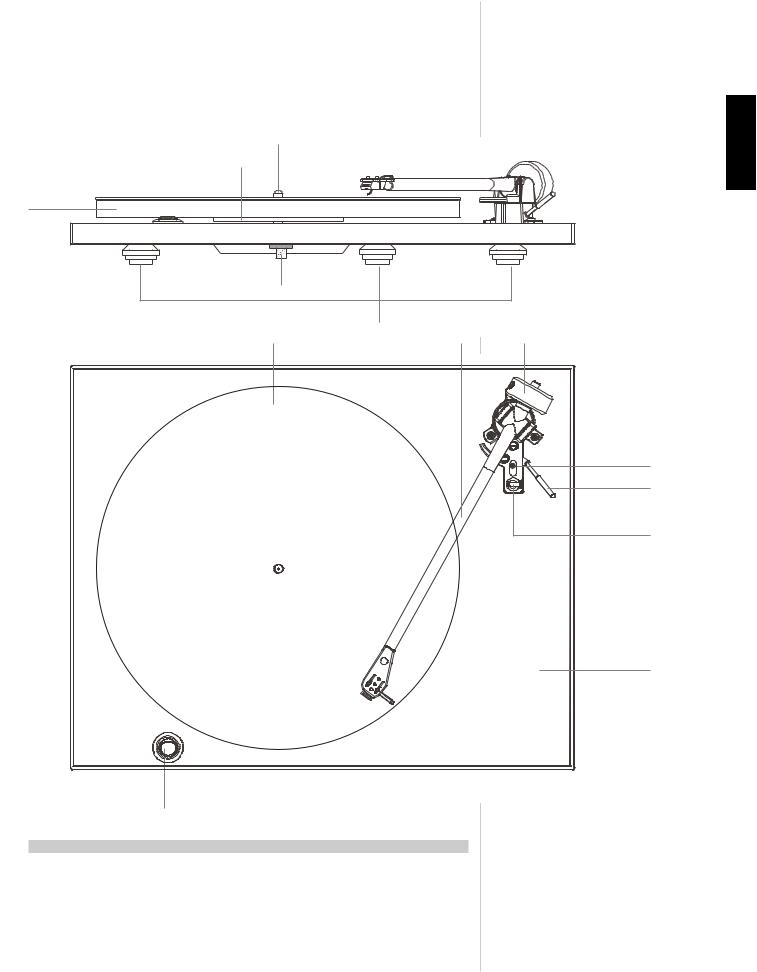Nad C552, C555I owners Manual

C555i/C552_8lang_v01.cdr 27/02/2008


 ® Turntable
® Turntable
C555i/C552
NAD Turntable - Owner’s Manual
Platine Tourne-disques NAD - Manuel d’Installation
Der Plattenspieler NAD - Bedienungsanleitung
De NAD platenspeler - Gebruikershandleiding
El Tocadiscos NAD - Manual del Usuario
Piattaforma girevole NAD - Manuale delle Istruzioni
O Gira-discos NAD - Manual do Proprietário
NAD Skivspelare- Bruksanvisning
SVENSKA PORTUGUÊS ITALIANO ESPAÑOL NEDERLANDS DEUTSCH FRANÇAIS ENGLISH

C555i/C552_8lang_v01.cdr 27/02/2008
IMPORTANT SAFETY INSTRUCTIONS
EXPLANATION OF GRAPHICAL SYMBOLS
The lightning flash with arrowhead symbol, within an equilateral triangle, is intended to alert the user to the presence of uninsulated “dangerous voltage” within the product’s enclosure that may be of sufficient magnitude to constitute a risk of electric shock to persons.
The exclamation point within an equilateral triangle is intended to alert the user to the presence of important operating and maintenance (servicing) instructions in the literature accompanying the appliance.
PRECAUTIONS
Read the Operating Instructions carefully and completely before operating the unit. Be sure to keep the
Operating Instructions for future reference. All warnings and cautions in the Operating Instructions and on the unit should be strictly followed, as well as the safety suggestions below.
INSTALLATION
1Water and Moisture - Do not use this unit near water, such as near a bathtub, washbowl, swimming pool, or the like.
2Heat - Do not use this unit near sources of heat, including heating vents, stoves, or other appliances that generate heat. It also should not be placed in temperatures less than 5°C (41°F) or greater then
35°C (95°F).
3Mounting surface - Place the unit on a flat, even surface.
4Ventilation - The unit should be situated with adequate space around it so that proper ventilation is assured. allow 10 cm (4 in.) clearance from the rear and the top of the unit, and 5 cm (2 in.) from each side. - Do not place on a bed, rug, or similar surface that may block the ventilation openings. -
Do not install the unit in a bookcase cabinet, or airtight rack where ventilation may be impeded.
5Objects and liquid entry - Take care that objects or liquids do not get inside the unit through the ventilation openings.
6 Carts and stands- When placed or mounted on a stand or cart, the unit should be moved with care. Quick stops, excessive force, and uneven surfaces may cause the unit and cart to overturn or fall.
7 Condensation- Moisture may form on the CD pickup lens when:
The unit is moved from a cold spot to a warm spot.
The heating system has just been turned on.
The unit is used in a very humid room.
The unit is cooled by an air conditioner.
When this unit has condensation inside, it may not function normally. Should this occur, leave the unit for a few hours, then try to operate again.
8 Wall or ceiling mounting - The unit should not be mounted on a wall or ceiling, unless specified in the Operating Instructions.
WARNING! TO REDUCE THE RISK OF FIRE OR ELECTRONIC SHOCK, DO NOT EXPOSE
THIS APPLIANCE TO RAIN OR MOISTURE
This product is manufactured to comply with the radio interference requirements of EEC DIRECTIVE 89/68/EEC and 73/23/EEC

C555i/C552_8lang_v01.cdr 27/02/2008
IMPORTANT SAFETY INSTRUCTIONS
ELECTRIC POWER
1Power Sources- Connect this unit only to power sources specified in the Operating Instructions, and as marked on the unit.
2Polarization - As a safety feature, some units are equipped with polarized AC power plugs which can only be inserted one way into a power outlet. If it is difficult or impossible to insert the AC power plug into an outlet, turn the plug over and try again. If it still does not easily insert into the outlet, please call a qualified service technician to service or replace the outlet. To avoid defeating the safety feature of the polarized plug, do not force it into a power outlet.
3AC power cord- When disconnecting the AC power cord, pull it out by the AC power plug. Do not
pull the cord itself.
 Never handle the AC power plug with wet hands, as this could result in fire or shock.
Never handle the AC power plug with wet hands, as this could result in fire or shock.
 Power cords should be routed to avoid being severely bent, pinched, or walked upon. Pay particular attention to the cord from the unit to the power socket.
Power cords should be routed to avoid being severely bent, pinched, or walked upon. Pay particular attention to the cord from the unit to the power socket.
 Avoid overloading AC outlets and extension cords beyond their capacity, as this could result in fire or shock.
Avoid overloading AC outlets and extension cords beyond their capacity, as this could result in fire or shock.
4Extension cord- To help prevent electric shock, do not use a polarized AC power plug with an extension cord, receptacle, or other outlet unless the polarized plug can be completely inserted to prevent exposure of the blades of the plug.
5When not in use - The primary method of isolating the turntable from the mains supply is to disconnect the mains plug. Ensure that the mains plug remains accessible at all times. Unplug the AC power cord from the AC outlet if the unit will not be used for several months or more.
CAUTION
Modifications or adjustments to this product, which are not expressly approved by the manufacturer, may void the user’s right or authority to operate this product.
MAINTENANCE
Clean the unit only as recommended in the Operating Instructions.
DAMAGE REQUIRING SERVICE
Have the unit serviced by a qualified service technician if
 The AC power plug has been damaged.
The AC power plug has been damaged.
 Foreign objects or liquid have got inside the unit.
Foreign objects or liquid have got inside the unit.
 The unit has been exposed to rain or water - The unit does not seem to operate normally.
The unit has been exposed to rain or water - The unit does not seem to operate normally.
 The unit exhibits a marked change in performance.
The unit exhibits a marked change in performance.
 The unit has been dropped, or the cabinet has been damaged
The unit has been dropped, or the cabinet has been damaged
DO NOT ATTEMPT TO SERVICE THE UNIT YOURSELF
OWNER’S RECORD
For your convenience, record the model number and serial number (you will find them on the rear of your set) in the space provided below. Please refer to them when you contact your dealer in case of difficulty.
Model No. :
Serial No. :

C555i/C552_8lang_v01.cdr 27/02/2008
This turntable has been engineered to give extremely good musical reproduction. Inherent in the design are several features that improve sound quality and focus the manufacturing costs where they are most needed.
Example: Speed change is achieved by manually moving the drive belt from one pulley to another as shown below.
ENGLISH
33rpm |
45rpm |
The cost saving from the use of manual speed change allows a very expensive low vibration motor with an accuracy exceeding that of conventional designs to be employed.
TIPS AND SUGGESTIONS
1Try to mount the turntable on a rigid, level surface. A light shelf screwed to the wall or in an alcove would be ideal. Avoid mounting on hollow or heavy cabinets, or anything mounted on a wooden floor.
2Try to keep the lid closed whilst playing records. This will prevent dust falling onto the records and make cleaning unnecessary. There may also be a sound improvement.
3Don’t use a record cleaner that works as the record plays, or any cleaners that use water or fluids.
Don’t touch the playing surface of records. Visible dust on the record surface is simply brushed aside by the stylus, and any that collects there can easily be blown away.
4Try to leave the turntable running during a record playing session. Switch on before the start, and only switch off after the last record has finished. Changing records whilst the platter revolves is easier than it sounds!
5DO NOT lift the centre hub from its bearing. The bearing is factory assembled with a film of thick lubricant. Disturbance of this can cause serious problems with speed variation and wear.
6When switching on the turntable, especially at 45rpm, it is recommended to give the platter a quick spin clockwise as the ‘ON’ switch is pressed. This relieves strain on the motor and belt.
7No maintenance should be necessary. If the turntable is working well, leave it alone. Some settling of the anti-vibration feet may cause the turntable to lean backwards slightly after a few months, but this is nothing to worry about.
8Don’t use any polishes on the turntable or lid. To clean or dust, wipe gently with a soft cotton duster (slightly damp, only if necessary).
9The tonearm is automatically earthed (or ground) through the arm cable screening. No other earthing should be necessary.
10Save the packing, in case the turntable has to be transported in the future.
11When the record reaches the end of one side, remember to lift the stylus off the surface of the record using the lift/lower mechanism.
ENJOY THE MUSIC!
4

C555i/C552_8lang_v01.cdr 27/02/2008
|
|
ARM WIRING |
CARTRIDGE |
|
Blue = LH earth |
Your NAD C555i/C552 turntable comes with a factory fitted moving magnet cartridge. |
Green = RH earth |
|
When following the setting-up instructions, please note that the optimum tracking weight is 1.7 grams |
Red = RH signal |
|
for the cartridge. The bias adjustor should then be set to the same setting. |
White = LH signal |
|
Replacement styli are available from your NAD dealer.
Spindle
Sub platter
Platter
|
Bearing |
|
|
Anti-vibration feet |
|
Mat |
Tonearm |
Counterweight |
|
|
Bias adjustment |
|
|
Lift/lower |
|
|
mechanism |
|
|
Arm clip |
|
|
Plinth |
On/off switch
SETTING UP THE CARTRIDGE
With the cartridge fitted using the alignment protractor supplied and the wiring chart (shown left), next set the tracking force and thrust bias.
First, slide off the plastic protection shroud from the cartridge - carefully! Unclip the arm from its
Holder and make sure that the bias adjuster is set to zero, use the balance weight to ‘float’ the stylus about 1mm clear of a record, then dial inwards with the weight, (1 complete turn = 2g) until the cartridge’s tracking weight is achieved. Finally, set the bias adjuster to the same setting.
ENGLISH
5

C555i/C552_8lang_v01.cdr 27/02/2008
ENGLISH
C 555i CARTRIDGE SPECIFICATION: GOLDRING ELECTRA
TRANSDUCER CHARACTERISTICS |
|
Frequency response |
20Hz - 20 kHz ±3dB |
Channel balance |
2dB at 1 kHz |
Channel separation |
20dB at 1 kHz |
Output level |
5mV ±2dB at 1 kHz at 5cm/s |
Static compliance |
16mm/N |
Equivalent tip mass |
0.7mg |
Vertical tracking angle |
26 degrees |
Stylus radius |
Elliptical 0.00072” x 0.0003” / 18µ x 7µ |
Stylus type |
replaceable |
ELECTRICAL CHARACTERISTICS |
|
Load resistance |
47k ohms |
Load capacitance |
150 - 400pF |
Internal inductance |
560mH |
Internal resistance |
700 ohms |
MECHANICAL CHARACTERISTICS |
|
Cartridge weight |
4.2g |
Fixing centres |
0.5” / 12.7mm |
Tracking weight |
1.5 - 2.0g (1.7g nominal) |
|
|
C 552 CARTRIDGE SPECIFICATION: ORTOFON OM5E |
|
TRANSDUCER CHARACTERISTICS |
|
Frequency response |
20-20.000 Hz ± 2 dB |
Channel balance |
2dB at 1 kHz |
Channel separation |
22dB at 1 kHz 15dB at 15kHz |
Output voltage at 1000 Hz, 5cm/sec. |
4mV |
Tracking force range |
1,5-2,0 g (15-20 mN) |
Tracking force, recommended |
1,75 g (17,5 mN) |
Vertical tracking angle |
20 degrees |
Stylus radius |
r/R 8/18 µm |
Stylus type |
Elliptical 0.00072” x 0.0003” / 18µ x 7µ |
ELECTRICAL CHARACTERISTICS |
|
Recommended load resistance |
47k ohms |
Recommended load capacitance |
200 - 600pF |
Internal inductance |
450mH |
Internal impedance, DC resistance |
750 ohms |
MECHANICAL CHARACTERISTICS |
|
Cartridge weight |
5 g |
Tracking weight |
1.5 - 2.0g (15-20 mN) |
Replacement stylus unit |
Stylus 5 E |
|
|
C 555i/C 552 SPECIFICATIONS |
|
TURNTABLE |
|
Drive system |
Belt drive |
Motor |
High torque synchronous motor |
Speeds |
33.3 and 45.1 rpm |
Suspension system |
3 energy absorbent synthetic rubber feet |
TONEARM |
|
Operation |
Manual |
Length |
289mm total length - 244mm pivot to stylus |
Effective mass |
9 grams |
Overhang |
19.1mm |
Cable capacitance |
150-400pF |
PHYSICAL SPECIFICATIONS |
|
Dimensions (WxHxD) with dust cover down |
173/8 x 4 9/16 x 14” / 447 x 115 x 356mm |
Net Weight |
11.57lb / 5.25kg |
Shipping Weight |
15.21lb / 6.9kg |
6

C555i/C552_8lang_v01.cdr 27/02/2008
Cette platine tourne-disques a été conçue et fabriquée pour une reproduction musicale d’excellente qualité. Dès la phase de conception, les fonctionnalités ont été centrées sur une amélioration de la qualité sonore de manière à consacrer les coûts de la fabrication aux points les plus importants.
Exemple : Le changement de vitesse se fait en déplaçant la courroie d’entraînement d’une poulie à une autre, comme le montre le schéma ci-dessous.
33 tr/mn |
45 tr/mn |
L’économie réalisée grâce à ce changement de vitesse manuel a permis d’incorporer un moteur très onéreux, dont le niveau vibratoire est extrêmement bas et la précision bien supérieure aux modèles traditionnels.
CONSEILS ET SUGGESTIONS
1Dans la mesure du possible, posez la platine tourne-disques sur une surface plane et rigide. Une
étagère légère vissée au mur ou dans une alcôve sont des solutions idéales. Évitez de poser la platine sur un meuble creux ou lourd, ou sur n’importe quel meuble posé sur un sol en bois.
2Dans la mesure du possible, le couvercle doit rester fermé pendant la lecture des disques. Cette précaution empêche la poussière de se déposer sur les disques et rend leur nettoyage inutile. Elle permet aussi d’améliorer la reproduction du son.
3N’utilisez pas d’appareil qui nettoie les disques pendant la lecture, ni de dispositif de nettoyage qui fonctionne avec de l’eau ou un liquide quelconque. Ne touchez pas la surface de lecture des disques. Toute poussière visible à la surface du disque est simplement balayée par la pointe; en cas d’accumulation de poussières au niveau de la pointe, il suffit de la dégager en soufflant dessus.
4Dans la mesure du possible, laissez tourner le plateau en permanence pendant une séance d’écoute de disques. Mettez l’appareil en marche avant de commencer et ne l’éteignez pas avant la fin du dernier disque. Changer un disque alors que le plateau tourne, ce n’est pas aussi facile que l’on puisse le penser !
5NE SOULEVEZ PAS l e moyeu central de son palier. Le palier a été assemblé chez le fabricant avec une couche de lubrifiant épais. Si vous dérangez cet assemblage, cela peut entraîner de graves problèmes d’usure et d’oscillations de vitesse.
6Lorsque vous mettez la platine tourne-disques en marche, surtout à 45 tr/mn, il est recommandé de lancer manuellement le plateau dans le sens des aiguilles d’une montre au moment où vous appuyez sur le bouton “MARCHE”. En procédant ainsi, vous diminuerez les contraintes sur le moteur et la courroie.
7Aucune maintenance n’est normalement nécessaire. Si la platine tourne-disques fonctionne correctement, ne touchez à rien. Après quelques mois, il se pourrait que les pieds antivibratoires se tassent un peu, faisant pencher la platine légèrement en arrière, mais cela ne doit susciter aucune inquiétude.
8N’utilisez aucun produit pour nettoyer la platine ou son couvercle. Pour éliminer la poussière, essuyez doucement avec un chiffon doux (légèrement humecté si c’est vraiment nécessaire).
9Le bras de lecture est automatiquement relié à la terre (ou à la masse) via le blindage du câble du bras. Aucune autre mise à la terre ne devrait être nécessaire.
10Conservez les emballages, pour le cas où vous auriez besoin de transporter la platine tourne-disques
à nouveau.
11Lorsque vous avez fini d’écouter une face d’un disque, n’oubliez pas de relever la pointe de la surface du disque en vous servant du lève-bras.
IL NE VOUS RESTE PLUS QU’À PROFITER DE LA MUSIQUE !
FRANÇAIS
7

C555i/C552_8lang_v01.cdr 27/02/2008
CÂBLAGE DU BRAS |
CELLULE DE LECTURE |
|
Bleu = Masse droite |
Votre platine tourne-disques NAD C 555i/C 552 est équipée à l’origine d’une cellule de lecture |
|
Vert = Masse gauche |
À aimant mobile. Lorsque vous suivez les instructions de configuration, veuillez noter que la force |
|
Rouge = Signal droit |
D’appui optimale est de 1,7 grammes pour la cellule. Le réglage de l’antiskating doit donc être à la même |
|
Blanc = Signal gauche |
valeur. |
|
|
Des pointes de rechange sont disponibles auprès de votre revendeur NAD. |
|
Axe
Plateau interne
Plateau
FRANÇAIS
|
Palier |
|
|
Pieds antivibratoires |
|
Couvre-plateau |
Bras |
Contrepoids |
|
|
Réglage de |
|
|
l’antiskating |
|
|
Lève-bras |
|
|
Agrafe de bras |
|
|
Support |
Interrupteur Marche/Arrêt [On/Off] |
|
|
CONFIGURATION DE LA CELLULE
Après avoir mis en place la cellule de lecture en vous servant du compas d’alignement fourni, et en vous référant au schéma de câblage (à gauche), réglez la force d’appui et la force antiskating. Tout d’abord, en faisant très attention, retirez la protection en plastique de la cellule.
Dégrafez le bras de son support, après avoir vérifié que le réglage antiskating affiche zéro, et utilisez le contrepoids pour faire “flotter” la pointe environ 1 mm au dessus de la surface d’un disque, puis vissez le contrepoids (1 tour complet = 2 g) pour régler le force d’appui de la cellule. Pour terminer, affichez la même valeur sur l’antiskating.
8

C555i/C552_8lang_v01.cdr 27/02/2008
C 555i CARACTÉRISTIQUES DE LA CELLULE: GOLDRING ELECTRA
TRANSDUCTEUR |
|
Réponse en fréquence à ±3 dB |
20 Hz à 20 kHz |
Symétrie des canaux |
2 dB à 1 kHz |
Séparation des canaux |
20 dB à 1 kHz |
Niveau de sortie à ±2 dB |
5 mV à 1 kHz, à 5 cm/s |
Compliance latérale statique |
16 mm/N |
Masse équivalente à l’extrémité |
0,7 mg |
Angle vertical |
26 degrés |
Taille de la pointe |
Elliptique 18 µ x 7 µ |
Type de pointe |
échangeable |
ÉLECTRIQUES |
|
Résistance de charge |
47 k-ohms |
Capacitance de charge |
150 à 400 pF |
Inductance interne |
560 mH |
Résistance interne |
700 ohms |
MÉCANIQUES |
|
Poids de la cellule |
4,2 g |
Axes de fixation |
12,7 mm |
Force d’appui |
1,5 à 2,0 g - 1,7 g nominale |
|
|
C 552 CARACTÉRISTIQUES DE LA CELLULE: ORTOFON OM5E |
|
TRANSDUCTEUR |
|
Réponse en fréquence à |
20-20.000 Hz ± 2 dB |
Symétrie des canaux |
2 dB à 1 kHz |
Séparation des canaux |
22dB at 1 kHz 15dB at 15kHz |
Niveau de sortie à 4 mV à 1 kHz, à 5 cm/s |
|
Tracking force range |
1,5-2,0 g (15-20 mN) |
Tracking force, recommended |
1,75 g (17,5 mN) |
Angle vertical |
20 degrés |
Taille de la pointe |
r/R 8/18 µm |
Type de pointe |
Elliptical 0.00072” x 0.0003” / 18µ x 7µ |
ÉLECTRIQUES |
|
Résistance de charge |
47 k-ohms |
Capacitance de charge |
200 à 600 pF |
Inductance interne |
450mH |
Résistance interne |
750 ohms |
MÉCANIQUES |
|
Poids de la cellule |
5 g |
Tracking weight |
1.5 - 2.0g (15-20 mN) |
Replacement stylus unit |
Stylus 5 E |
|
|
C 555i/C 552 - CARACTÉRISTIQUES |
|
ENSEMBLE PLATEAU |
|
Entraînement |
Courroie |
Moteur |
Moteur synchrone à couple élevé |
Vitesses |
33,3 et 45,1 tr/mn |
Suspension |
3 pieds absorbeurs d’énergie en |
|
caoutchouc synthétique |
BRAS |
|
Fonctionnement |
Manuel |
Longueur |
289 mm longueur totale |
|
244mm entre l’axe et la pointe |
Masse effective |
9 grammes |
Avance |
19,1 mm |
Capacitance du câble |
150 à 400 pF |
ENCOMBREMENT ET POIDS |
|
Dimensions hors tout (LxHxP), couvercle fermé |
447 x 115 x 365 mm |
Poids net |
5,25 kg |
Poids emballé |
6,9 kg |
FRANÇAIS
9
